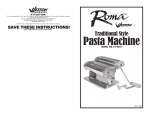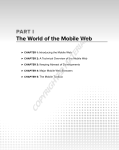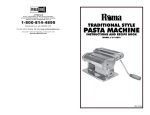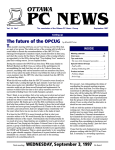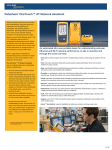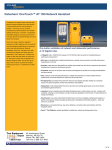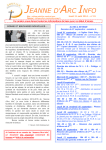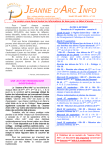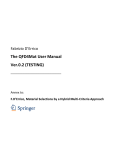Download From Theory to Practice Keynote User Guide About Me Four Sets of
Transcript
2/4/2009 From Meta-Principles to Design Practices From Theory to Practice Where Worthwhile Interaction Designs Come From and How To Get There m Principles for design(ing) m m m Gilbert Cockton m Research Chair, Human-Computer Interaction Progressive instantiation m Department of Computing, Engineering and Technology University of Sunderland m NESTA Fellow 2005-2007 m Keynote User Guide m m Two hours allocated Breach of Geneva Convention m m Cruel and Unusual Punishment m m m Plus some discussion/question gaps 1. Meta-principles Break 2. Constraining design choices 3. Supportive WCD framework of design and evaluation approaches Four Sets of HCI Principles m m m m m Gould & colleagues (IBM, Usability) Shneiderman (Direct Manipulation) Dourish (Embodied Interaction) Brown (IDEO, Design Thinking) Constrain design choices by craft and purpose Support design choices with a development framework of design and evaluation approaches Principle sets completed on a project/team/ organisation basis About Me m HCI Research Chair since 1997 m Research student 1983-86 m m Keynote split into two with a break m Four example post-hoc sets of principles Limitations of a posteriori derivations A priori alternative, six meta-principles m m Before that, secondary school teacher, History and Social Studies (History and Education MA) Post-Doc 1986-89 m m ‘allowed to teach’, not required! PhD 1993! Academic at Glasgow (GIST co-founder) then Northumbria via flexible work Industry/consultancy work since 1985 Gould, Lewis and Others 1. 2. 3. 4. Early focus on users and tasks Empirical measurement Iterative design (Integrated Design) Then an alternative approach from my NESTA fellowship work 1983 1 2/4/2009 Ben Shneiderman (Direct Manipulation) 1. 2. 3. 4. Continuous representation of the object of interest Physical actions or labelled button presses instead of complex syntax Rapid, incremental, reversible operations whose impact on the object of interest is immediately visible Layered or spiral approach to learning that permits usage with minimal knowledge. Paul Dourish (Embodied Interaction) 1. 2. 3. 4. 5. 6. Computation is a medium Meaning arises on multiple levels Users, not designers, create and communicate meaning Users, not designers, manage coupling Embodied technologies participate in the world they represent Embodied interaction turns action into meaning 1983 2001 Tim Brown (Design Thinking) 1. 2. 3. 4. 5. Hit the streets Recruit T-shaped people Build to think The prototype tells a story Design is never done. Are these the same sorts of principle? A. What sorts of principle are there? B. How are they derived and defended? What do you think? 2005 A. Five Senses of Principle Concise Oxford English Dictionary 1. 2. 3. 4. 5. A fundamental truth or law as the basis of reasoning or action A personal code of conduct, (in plural) rules of conduct A general law in physics etc. A law of nature forming the basis for the construction or working of a machine etc. A fundamental source; a primary element B. 3 x 2 x 2 Bases for Derivation m Aristotle, Nicomachean Ethics 1. Knowing (Theoria, Sophia, Episteme) 2. Making (Techne, Poesis, Phronesis) 3. Doing (Praxis, Phronesis, …) m Kant and many others 1. a posteriori, based on experience 2. a priori, based on deduction m Research sources 1. Primary 2. Secondary 2 2/4/2009 Our Four Sets of HCI Principles m All a posteriori derivations m m m m Gould++, Dourish: knowing Shneiderman, Gould++*: making Brown: doing, making Mostly primary in their sources m m m Trust m m m m m Start with an introductory text’s position on design outcomes, John Heskett, Design: A Very Short Introduction (cut down Toothpicks and Logos) “result from … decisions … Choice implies alternatives, in how ends can be achieved, and for whose advantage. … design is not only about initial decision or concepts by designers, but also about how these are implemented and by what means we can evaluate their effect or benefit” Primary sources cannot be fully revealed for inspection (except artefact corpora for making) Overcommitment One approach to evaluation or user research Focus on artefacts or people, not both Scope Dourish uses secondary ones Gould and colleagues should have (e.g., Dreyfuss Designing for People) An a priori alternative m Limitations of a posteriori approaches m m m Direct Manipulation principles don’t cover all interaction designs Can’t go from humans to designs, or vice versa IDEO set the best balanced here (but then, they are designers) Choice Theory (Allingham) [design outcomes] result from … decisions … Choice implies alternatives m Choice Theory calculates the bases of rational choice Selections from menus of alternatives m m What do we expect of any choice? m Good selections, good menus or both? Especially a design choice? m (Heskett 2002, pp. 5-6) What Makes a Good Menu? there's egg and bacon; egg sausage & bacon; egg and spam; egg bacon & spam; egg bacon sausage & spam; spam bacon sausage & spam; spam egg spam spam bacon and spam; spam sausage spam spam bacon spam tomato & spam 1: Receptiveness m Not just having spam m Pizza toppings fare better m m m Or just egg, sausage and bacon as well Arrabiata, Hawaiian, Curry, Cajun, … Receptive to international influences m Staying open to alternatives m Receptiveness m m Positively seeking them out First meta-principle of abstract choice 3 2/4/2009 What Makes a Good Menu? 2: Expressivity m m To make a fair choice from a menu, all options must be well expressed It’s hard to choose an option that you don’t understand m m m m Expressivity m Bad Choices or Bad Menu? Lord Montague’s Welsh Pomfrey The Oudenaarde Waterzooi Mrs. Ainley’s Lane’s Prince Albert Pie Second meta-principle of abstract choice Committedness and Choice m Are good choices from bad menus possible? m m m Poorly expressed options obstruct confidence Unreceptive menus have obvious inadequacies Bad menus undermine committedness m m Third meta-principle of abstract choice Genuine choices must be committed to m m m Credibility: a fourth meta-principle? m All menu options must be credible as well as well expressed m m m Yes, credibility requires a context and an audience m m m Is credibility wholly about choice from a menu? Is something beyond rational choices based on abstract utility involved? Context is largely ignored in choice theory m Rationality ≠ credibility Contexts differ for different sorts of choices, e.g., design decisions (or dealing with nut allergies) We have reached a point where reflecting on abstract menu choices will take us no further Applies to the chooser, not the choice Knowing what we have chosen and why What makes it possible to commit? Where Design Outcomes Come From “result from … decisions … Choice implies alternatives, in how ends can be achieved, and for whose advantage. … design is not only about initial decision or concepts by designers, but also about how these are implemented and by what means we can evaluate their effect or benefit” (Heskett 2002, pp. 5-6) Credibility now has a context for design decisions, beyond abstract options 4 2/4/2009 ends, for whose advantage, how implemented, by what means evaluated 4: Credibility: Choices in Context m Evaluation Beneficiaries achieved? All genuine options for each class of choice (menu types) must be individually credible, but so must the relationships between choices m achievable? m m Credibility m Credibility (and more) applies to all connections between choice classes m Means association Ends Two Types of Choice Are Special Two extra meta-principles follow from questions for two design choice classes m m m m We do more than commit to an evaluation We also commit to follow through … … unless we just need ‘usability approval’ A1: Worthwhile Interconnections Evaluation Means 5: Inclusiveness m Beneficiaries association Ends A2: One Last Interconnection Required by first specific question m m m achieved? achievable? m Q1: Are choices of beneficiaries the same as choices of means? Q2: What should we do when evaluation indicates that some ends have not somehow been achieved? Designing as connecting (Interactions July 2008) m Clement Mok, Stephano Marzano, Sir George Cox, RSA Student Design Competition, … Choices about people are special because people are Choices need to be more than credible Evaluation achieved? Beneficiaries association Ends Choices about people are moral (all of us) or economic/ethical (some of us) m Ends should imply beneficiaries, who to include? Means also imply cost impacts, perhaps including groups beyond those chosen as design beneficiaries m Economic/Ethical: costs of purchase, configuration, use, integration, maintenance, indirect impact, … m Moral: Accessibility, sustainability, … m Virtuous: golden means between vices of extremes m Generally axiological, all about value(s) achievable? m Means benefits m Both design means and evaluation measures and criteria should be credible with respect to ends Means should also be credible through evaluation (inspection: feasibility, aesthetics etc.) Benefits should be credible through evaluation (investigation: testing, usage studies, surveys etc.) benefits Context: Four Interconnected Classes of Menus for Design Choices 5 Total Iteration Potential 6: Improvability m Evaluation should establish whether ends have been achieved (6.1 Evaluability) and what to improve Response to second specific question: if ends are not well achieved … m m m m m m m m m m m credibility We must understand how to improve … m 6.2 Understandability … and be able to make improvements Receptiveness of virtuous designers Expressivity of design content Committedness of virtuous designers Credibility of design decisions Inclusiveness of virtuous designers Improvability within design process Revealed through the magic of words m responsiveness m 6.3 Responsiveness Three subprinciples of improvability (6.[1-3]) m RITE Questions: Problem?, Understand?, Fix? Six Meta-Principles for Designing m understandability inclusiveness … we must stay committed to or make a new choice … … or choose new means, beneficiaries, even evaluations. Total iteration potential, not just ‘design’ iteration If something needs to improve, it should be improved, otherwise evaluation is pointless m m committedness receptiveness m evaluability Improvability 2/4/2009 Red Cross Break m m Geneva Convention requires a break at this point … Resume in 10 minutes “conceptual and logical investigation” that cannot “be solved by empirical means” A.C.Grayling, Wittgenstein, 2001 From Meta-Principles to Design Practice m Meta-principles are too abstract to guide action, but they do provide broad heuristics for design and evaluation methods m m m m m m m Participative Design supports receptiveness, but not … Personas support expressiveness, but not … RITE (MS) supports improvability, but not … Social construction of reality limits the extent of instantiation before specific team/project contexts m Getting Started m Can’t fully programme humans or their work (especially creative work) Actionable codes/rules of conduct must be finalised on team/project bases (get close but don’t close) Teams must find their own virtuous ‘golden means’ Limit four choice classes to Interaction Design via craft (materials) and axiological (design purpose) constraints Support project teams via frameworks of approaches (not ‘methods’) m m m Enough support to guide project teams Enough freedom to work effectively as needed for the project and/or by the team, their organisation and sponsors Progressive partial instantiation 6 2/4/2009 Craft-Axiological Constraints Restrict means to materials of Interaction Design m m m Measure and critique Socio-digital systems (post sociotechnical) People are part of our materials m m m m What is the purpose of design? ISO 9241: Efficiency, effectiveness, satisfaction User Experience: emotional usability and more Contextual Design: fit to context Ludic Design: Fun m Other Reflective Stances: interpretative etc. Worth: favourable balance of benefits over costs for beneficiaries within a sociodigital system m Acceptable impact for negative ‘beneficiaries’ interaction Worth Placing the other principles inspection m Socio-digital System (SDS) Recap: Keynote Part 2 m Illustration of alternative a priori derivation of design meta-principles m Constrain Heskett’s 4 choice classes Streets/ Work Empirical Measures m m m m Artefact (inter)action Meaning Support from Existing Approaches Receptiveness m Participative development, field studies, reflective design, value-sensitive design, designs, trends, inventions, … m Expressivity m Credibility m m m Improvability m m Stakeholder analysis, plus aspects of accessibility, reflective design, value-sensitive design, sustainability, … RITE; evaluability: user testing and inspection, understandability: Activity Theory, Distributed Cognition, User Experience Theories etc. Craft constraints: socio-digital materials of Interaction Design Axiological constraints: the purpose of design is to demonstrate the achievement of worth by identified beneficiaries via aligned evaluations Support with framework of worth-centred design and evaluation approaches m Committedness m Receptiveness and Inclusiveness m Expressivity m Credibility m Improvability (4) m m Design Rationale, Task/Scenario Analyses, Technical Feasibility Analysis, Grounded Theory, Interaction Design studies, … Inclusiveness Heskett as an example starting point Worth-Centred Innovations Personas, scenarios, sketching, (experience) prototyping, … m m SDS Actors Axiological constraints reflect design philosophies m m investigation motivation m Worth-Centred Interaction Design m m m Worth maps with element annotations (1) L-ERG-IKK worth webs (2) User Experience Frames (3) , Worth personas, Worth boards (adaptation of mood boards) Worth Delivery Scenarios (3) Element Measurement Strategies, Direct Worth Instrumentation, Total Iteration Potential Committedness? 7 2/4/2009 Worth Maps: WCD Approach 1 Van Hire Web Site Example Hiring a van to move something from one place to another Gift, purchase, sale or disposal Different goals, overlapping values m m m m Origins in hierarchical value models (HVMs) of consumer psychology, already in use in: m m Network models of intersecting and converging means-end chains (MECs) m m Information Systems (St. Gallen), Software Engineering (Australia), Web development (USA), Mobile HCI (Korea, Austria) associate product attributes with the UXs and valued outcomes of user interaction Direct support for designing as connecting m m Associating explicit means with explicit ends Interactions, July+August 2008 Worth Map Elements: Anatomy of WCD Style MECs User Experience (they had it) Good Value Clear, informative Quality (you achieved it) Price information and cost summary Feature (you configured it) Web pages with downloadable documents Material (you sourced it) Not in control of costs, over budget Worthwhile Economic Transaction Worthwhile Outcome (they achieved it) Human Value Elements (aiming and missing/hitting) Balance of Worth Worthwhile Economic Transaction means or ends, technical or human Van Hire Worth Map Pleasant Sequel Good Value Nicer home m In Control m Complete, checkable, thorough Helpful, considerate m What to bring & when information Web pages with dowloadable documents Not in control of costs, over budget Hirers can’t collect hired van Confirmation of booking Email and fax capabilities Load won’t fit into van/ more trips needed Web pages with downloadable documents Van load information Depot maps and directions information Image capabilities of html, java etc. Hirers arrive late at depot Inability to find van hire depot m m Chosen means and ends, associated in MECs Beneficiaries and evaluations also connected Worth Maps as an anchor representation m Price information & cost summary Price information and cost summary Committedness to designing as connecting m Concerned, caring, valuing (co-created: designs in use) Technical design elements (probing) Role of Worth Maps in WCD Successful gift, transfer or disposal Good Plan Clear, informative Clear, informative Not in control of costs, over budget Adverse Outcome (they may suffer it) Worthwhile Economic Transaction Good Value Ends (intended, discovered) Means Credibility relates to elements and associations Human Value Element annotations support Inclusiveness and evaluability Worth Maps must be fully augmented to support receptiveness and expressivity m m menus and options are external to worth maps so are details of inter-element associations 8 2/4/2009 Worth-Centred Development m Axiological constraints on non-craft design choices m m m Worth Webs: WCD Approach 2 m Consider balance of costs and benefits Assess existing design and evaluation approaches against constrained meta-principles Adapt and fill gaps as required Understanding ends and beneficiaries independently of technology m m m Upgrading users from scenic features in design Untethering people from usage ‘Web’ metaphor common in figurative and related sociology, framing device m m Weber, Arendt, Parsons, Elias, Giddens (locales) Individuals and spaces located within webs of overlapping social structures http://www.nancarrow-webdesk.com/warehouse/storage2/2007-w40/img.18276_t.jpg Individuals in Social Webs m m Life as a web of Self-Other relations Self: individual motivation m m m Beyond Bodies Social Services Alderfer: Existence, Relatedness, Growth Existence and growth of mind, body and spirit Parent Group Extended Family Other: collective structures mould agency m Parents Kin, Kind and Institutions m Families and similar groupings (e.g., gangs) m Communities of practice, interest, place, age, issue, faith/belief, gender, language/ethnicity … m Institutional: governmental, religious, commercial, charitable, educational, professional, scientific, advocacy/political, … Siblings Friends http://designflute.wordpress.com/2007/09/07/useful-gadgets-for-special-people/ Role of Worth Webs in WCD m Broadening scope of receptiveness m m m m L-ERG-IKK (alergic to theory!) Locales-Existence+Relatedness+GrowthKin+Kind+Institutions Webs create multiple places over spaces m User Experience Frames (UEFs) m m Understanding individuals in relation to their web of social contexts m m m m UEFs: WCD Approach 3 Role conflicts and responsibilities Value conflicts and priorities Potential beneficiaries/adverse impacts (worth) Multi-column expression of abstract interaction scenarios Explore credibility of UXs as the final means in means-end chains m m Does interaction deliver intended worth? Provide a focus for direct evaluation of user interaction: worth inspection Sociodigital system design opportunities m e.g., Job enrichment for van depot staff 9 2/4/2009 UEF Headers, Footers, Columns m UEFs use a tabular format to render UX as co-construction of meanings m m m And that’s a Good Plan for Hiring Our Van UX for Customer Stakeholder The name of a UX is its meaning to the user A UX’s meaning heralds outcomes No immediate outcomes: enables later In Control UX for van hire and use Columns for ideal dynamic elements of interaction m m Van Hire Example (Fragment) m Beliefs Better to start with depot Can find info on depots Not a good place to start Can find prices & availability (1) System Usage System Response Actions in the World 2. 4. Open www. lovelyvan.com 5. Feature 1: Price information and cost summary Enabling quality B: Concerned, caring, valuing Feature 2: What to bring and when summary Enabling quality C: Complete, accurate, checkable, thorough Feature 3: Email/fax confirmation of booking Feature 4: Van load information Enabling quality D: Helpful, considerate Feature 5: Depot maps and directions information Anticipation: positive from press campaign and friends’ recommendations Role of UEFs in WCD Expressivity 6. 7. m m m developed via Worth Delivery Scenarios Inclusiveness m m m Sally checks details EMS: WCD Approach 4 Element Measurement Strategies Evaluation measures (what) and instruments (how) are selected for each worth map element m Improvability evaluability and understandability follow from expected UX dynamics feelings are understood and assessed in context, no idealised separation of measurable emotions Display pdf Save and print confirmation page Sally saw a classified advert in the free Carlisle local paper and agreed to buy a second hand outdoor chaise longue after visiting the owner to have a look. All she and her husband Harry need to do now is to go and pay for it and pick it up. Sally was careful to check its measurements when she viewed it. It’s 206 x 67 x 54cm, so they visit www.lovelyvan.com, the web site of a national van hire franchise to hire a van to help the deliver it, as the chaise longue won’t fit into the back of their small hatch back with all the seats down. They’ve chosen www.lovelyvan.com after seeing a press campaign for the company, and some friends in London have used it and recommended it. Sally lets Harry drive their PC. He finds a prices and availability section on www.lovelyvan.com, but Sally asks him to check depot locations. There’s no point in checking on prices availability if the nearest depot isn’t close enough to their house and the vendor’s. There’s a clear area on the right of the home page for finding your nearest depot. Harry types in their post code and a map appears in the large blank space below showing the locations of nearby depots. A key below also lists depots. While Harry ponders the map, Sally notices their nearest on the list, in Carlisle Centre, around half way between their’s and the vendor’s. Harry clicks on this (under Sally’s index finger) and the map changes to a local one for the depot, with address and phone details, and driving directions. Harry is really impressed by the animations used in the transition from one map to another, and from the list to the depot details. “Cool!” he exclaims, but Sally’s finger is already over “which van do I need” button. Harry is confident that after all those fancy animations that the location map and depot details will stay there. Sure enough, another animated transition places a circle of vans in the blank area to the left. Next to each van there’s an example load and below that, there’s the van’s load space dimensions. Sally immediately spots the van with a settee next to it. “That should do” she says, but this time Harry’s finger has got there first. “Hang on,” he says “Let’s check the small print. OK, load space dimensions 240 long by 170 wide by 140cm high. Something 206 x 67 x 54cm will fit in easily, and there’ll be enough room down one side to manoeuvre it from inside the van. So, a medium panel van is what we want”. With that Harry clicks straight on the obvious red circular Book Me button over the right edge of the van photo. This time there are no fancy animations. The other vans disappear and a calendar appears in between the medium panel van and the depot details. It clearly indicates that there are medium panel vans available for the coming weekend. Below the calendar is a clear informative statement on hire periods, prices and depot opening times. Vans can be hired for up to 24 hours, or for short hires of up to four hours. The local depot is open from 8AM to 8PM over the weekend. Harry notices a ‘hire planner’ button below the information and moves the mouse to click it. “Hang on” says Sally, let’s see how much it is first.” “I can see,” says Harry “it will be £44 for four hours”. “The chaise longue was only £60” said Sally “that hardly seems worth it”. “A new one’s over £150,” said Harry “and you said it was as good as new. I can take some things to the recycling centre on my way back”. “In four hours?” asked Sally. “Maybe not, let’s see” said Harry and he clicks on a chunky ‘hire planner’ button. A simple spin box appears with 2 in it, with the label ‘Number of drops/pick ups’. Harry clicks this up to 3: “let’s see, there, here, recycling, yes, that’s 3”. He clicks on OK and text boxes pop up one by one to the right of the spin box. At either end is the depot’s post code in a non-editable text box, with the OK button moved to the right as well, but disabled. Their post code has been pre-entered into the third box. “That’s smart” says Harry “I just need to fill in the seller and recycling centre post codes”. He sees a link to UK post code look up, clicks on it and a web-site opens in a new window. Harry types in the names of the nearest main roads to the vendor’s house and the recycling centre, explaining to Sally that they will be good enough. As he gets each post code, he enters it into a blank text box, and presses the OK button once it is enabled. Three more text boxes appear below the post code ones labelled ‘time needed at each drop off/pick up’ with default editable times of 20 minutes in each. There’s an OK button at the end again, and Harry presses it: “If we’re quick, 20 at each will be enough”. A summary of the route comes up ‘From the van depot to … From … to your location. From your location to … to the van depot. It’s all clearly laid out, with a time estimate for each leg for the date and time, and a total time based on these legs and the time at each drop off/pick up. Below this is a very obvious clear statement that while lovelyvan have done their best they can to be accurate, they cannot guarantee time estimates. Sally is really impressed “that’s so helpful” she cries out. The total estimated time is three hours. “That’s enough leeway for us” says Harry “especially if we have everything clear for getting the chaise longue in and the recycling stuff is stacked up ready to go”. Harry selects a date and a time period, and navigates to the booking details and payment page, where Sally helps him with credit card and checking all details. Harry clickes the terms and conditions box (which pops up ‘Key Points’ when you hover over it). Harry saves and prints confirmation page. Within minutes Harry has an email from lovelyvan. It’s a well laid out html message with link to an on-line pdf as an alternative layout. Harry follows the link to the pdf out of curiosity. “That looks very smart” says Sally, and it is. The document contains details of the hire, the depot and directions to it, the documents that drivers need to bring, instructions on what to do at the depot and time estimates for these activities, and a map with the route between drop offs. There’s legal information at the end, but this is clear and well set out, and written in a reassuringly straightforward tone. Harry prints the pdf off, staples it, and pins it to the cork board near the PC. The pdf even looks good when pinned up. “I’m really looking forward to getting the chaise longue now” said Sally. “I’ll be glad to get all that stuff to the recycling” said Harry “much easier than I thought”. Credibility m m more than a worth element label Booked right van for right time period Worth Delivery Scenario for UEF Display home page Enabling quality A: Clear, informative Actions in the World Display and email confirmation 3. m System Response Book and pay for van Sally persuades Harry m System Usage Read email, follow link to pdf Feels great, all well planned now actions and responses of co-present others changes in the world (including people) Feelings m Have all necessary details Staple and pin up 1. m Looking forward to getting van Print pdf The Other End (UEF/UX start) m Beliefs Feelings, beliefs, user actions, system reactions, … Additional circumstance columns for contingent contextual worth processing factors (situatedness) m Feelings m Partially instantiates subprinciple of evaluability Measures and instruments for: m m design elements come from existing approaches to software/media quality; human value elements generally cannot be applied during interaction, worth comes later Meanings can be associated with stakeholders Balance of worth: positive and negative meanings Basis for Worth Map element annotations 10 2/4/2009 DWI: WCD evaluation insight m Direct Worth Instrumentation m m m direct collection of measures by instrumenting the technical system (logging) or the wider sociodigital system (instrumentation) measure what matters and endures in the world, as and when lasting outcomes form measure transient user experiences to diagnose degraded worth Role of EMSs in WCD m m Committedness to means of evaluation A big picture of what matters most m m m m Designs get better m establishing element measurement criteria supports expressivity for ends and increases receptiveness for means Heisencockton’simprovabilityprinciple! Worthwhile Outcomes m m m m Worthwhile economic transaction Pleasant sequel, successful delivery Adverse outcomes m Costs of control, load won’t fit, can’t collect van, late pick up, can’t find depot Need to instrument van hire depot and customers, not earlier web-site interactions m Still need to instrument some UXs, e.g., confidence in choices and preparation Summary m Three (1+1+½ +½) meta-principles implied by ordinary language analysis and choice theory Designing implies 3 more (½ +½+ 1+1) m Constrain Heskett’s four choice classes m Understandability within worth map context Evaluation planning can be completed before design finalisation m DWI: Van Hire Examples m m m m m close reading of Heskett’s position on outcomes Means of Interaction Design: Socio-digital materials Purpose of Design: Worth as one form of axiological constraint WCD framework of approaches partially instantiates meta-principles for constrained choices Final instantiation must occur on a studio, team or project basis m Approaches, not algorithms Concluding Claims m Meta-principles for designing and their initial worth-centred pre-instantiation … m m m Questions? … re-frame and support adaptation of most existing HCI approaches m Personas, scenarios, user testing, probes, … … highlight gaps in current HCI support m Representing commitments, e-valu-ation of costs as well as benefits, user experience as axiological meaning making, broad views of human values and their social contexts WiCkID! m Worth-Centred Interaction Design 11 2/4/2009 Thank You Gilbert Cockton Research Chair, Human-Computer Interaction School of Computing and Technology, University of Sunderland NESTA Fellow 2005-2007 12












